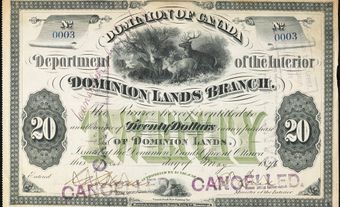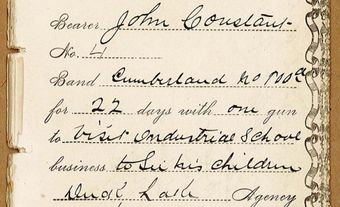From 1889 to 1897, the Canadian government’s Peasant Farm Policy set limits on Indigenous agriculture on the Prairies. The policy included rules about the types of tools First Nations farmers could use on reserve lands. It also restricted how much they grew and what they could sell. The Peasant Farm Policy was built on the belief that Indigenous farmers had to gradually evolve into modern farmers. It also reduced these farmers’ ability to compete with settlers on the open market. The policy ultimately impeded the growth and development of First Nations farms. As a result, First Nations never realized their agricultural potential.

What Is Peasant Farming?
Peasant farming refers to the use of only basic tools to grow crops and raise animals. It involves seeding and doing other tasks by hand, without the help of machines. Canadian officials modelled their policy for on-reserve farming after the ways of peasants (poor farmers) in Europe.
Treaty Provisions for Farming
The object of the Numbered Treaties was to assert Canadian sovereignty and clear the Prairies for settlement. (See History of Settlement in the Canadian Prairies.) As part of this plan, colonial agents sought to turn First Nations hunters and warriors into peasant farmers who were settled, Christian and under control.
The text of the Plains treaties allotted 640 acres (one square mile) of land to each family of five. This was in keeping with the average size of farms at the time. Further, each family that cultivated the soil would receive tools and farming implements, the specific types and number of which depended on the treaty. For example, Treaty 4 provided “two hoes, one spade, one scythe and one axe for every family.” It also gave each band “a chest of ordinary carpenter’s tools, five hand saws, five augers, one cross-cut saw, one pit-saw, the necessary files and one grindstone.” Treaty 6 supplied “four hoes for every family… two spades per family… one plough for every three families… one harrow for every three families… two scythes and one whetstone, and two hay forks… for every family… [and] one grindstone and one auger for each Band.”
However, First Nations were told during treaty negotiations that they would be “taught to live like the white man.” They therefore believed they would receive contemporary farming tools, including labour-saving devices such as threshing mills, reapers and mowers. Instead, they received hand tools and wild cattle.

Social Darwinism
Hayter Reed, the Indian agent at Battleford and later the assistant commissioner of the North-West Territories under Edgar Dewdney, created the Peasant Farm Policy while he was Indian commissioner in 1888. He and other bureaucrats believed in social Darwinism, and applied Charles Darwin’s evolutionary theories to groups of people. Reed and his peers held the racist belief that Indigenous peoples were at an earlier stage of evolution than white people. In their view, Indigenous farmers were not capable of using modern methods. They had to evolve using only hand tools and grow into modern farmers.
The Indian agents also believed that to supply Indigenous people with rations would encourage laziness. For that reason, the distribution of food was kept to a minimum. Reed was known as Iron Heart to the Plains peoples because he gave so little. The First Nations leadership affected by Treaty 6 reminded the government agents that the treaty promised help in times of famine and pestilence, and that this had been the principal reason they had signed the treaty. However, their requests fell on deaf ears.
The cultural differences between the Canadian government and the First Nations became apparent when the reserves were selected. The land that made up the reserves had previously been used collectively by First Nations. For example, land with berries could be used by all; pastureland could be shared; swamps and sloughs were valuable waterfowl habitat. This contrasted with the government’s concept of land ownership based on individual farms. Because of this, in some cases, farming plots were reduced from 640 acres per family to 40 acres per family.

Limited Markets
Indigenous farmers had already begun to excel and produce impressive crops before the Peasant Farm Policy was introduced. In 1884, the Fort MacLeod Gazette reported that the potato crop on the local First Nations reserves in southern Alberta was “immense.” The paper also reported that some Indigenous people “have made a pretty good thing selling them to citizens.” The Siksika reserves in southern Alberta were quite large and successful. These farmers were in no mood for peasant farming since they had adapted successfully.
However, many settlers complained about unfair competition. In 1888, they confronted Indian Commissioner Hayter Reed. For punishment for the North-West Rebellion of 1885, Reed limited the markets for the Indians in Battleford to the sale of firewood to the Department of Indian Affairs and a one-year sale to the Battleford industrial school. White settlers were exclusively allowed to sell their grain in the district. Reed felt that the Indigenous peoples should only produce enough for themselves, and that they should be self-sufficient and should not compete with outside farmers. Some Indigenous farmers had purchased contemporary farming implements, which were now forbidden. They protested this intrusion on their livelihood, but Reed remained steadfast in his position.
Reed’s actions in the Battleford Agency also informed national policy. This included the permit system, whereby an Indigenous farmer had to receive a permit from the Indian agent to sell his produce. That way, agents could control the sale of goods within the district in favour of the settler farmers.
Impact
This use of bureaucratic control combined with obsolete farm implements impeded the growth and development of First Nations farms. The impact of the Peasant Farm Policy was so great that First Nations farms ceased to be an economic asset and First Nations never realized their agricultural potential.
See also Dominion Lands Act; Pass System in Canada; Agriculture and Food Policy; Agricultural Economics.

 Share on Facebook
Share on Facebook Share on X
Share on X Share by Email
Share by Email Share on Google Classroom
Share on Google Classroom





